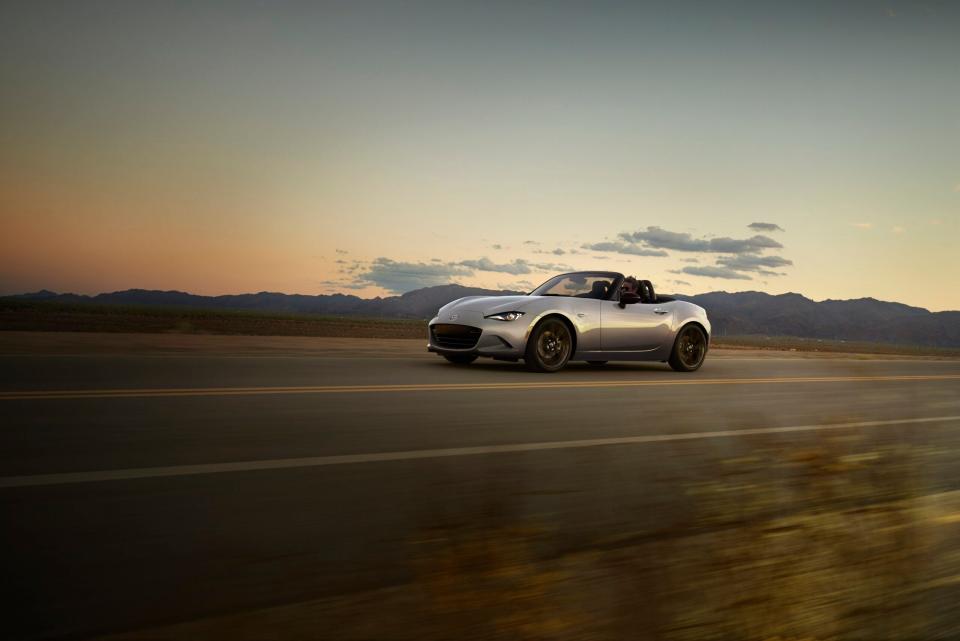The 2024 Mazda MX-5 Miata Is the Cure for What Ails Us
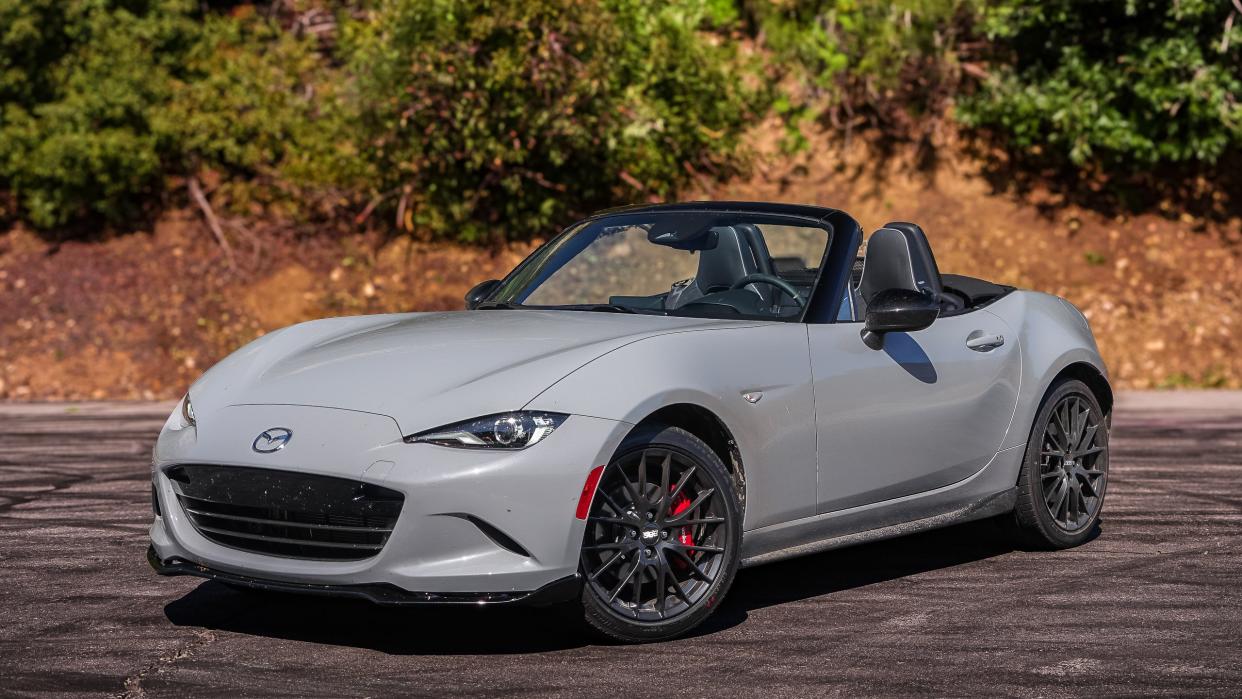
It seems like every car person has a story about a Mazda Miata. Maybe they owned a beat-up old NA that they wish they hadn’t sold or perhaps their now-spouse took them out on their first date in an NC Club Spec. Mazda’s little roadster has somehow become a part of all of our lives as automotive enthusiasts. This is true even for me, a giant man who really doesn’t fit comfortably in any of them: Mazda’s fourth-generation MX-5 Miata, aka the ND, was the first press car I ever got.
That was in 2017 and the car was a Soul Red Metallic Club trim with a soft top and a six-speed manual because that’s just the right way to do things. At the time, I was hosting a podcast for the Petersen Automotive Museum and working for the museum’s PR agency, but I wasn’t a journalist—yet. The week I had the Miata I got two pieces of bad news: First, I was being fired from my main gig at the agency. Second, my daily driver—a 1970 Mercedes-Benz 280SE—was going to need a new cylinder head after what I thought was a blown head gasket turned into serious galvanic corrosion. This repair would cost somewhere in the neighborhood of $6,700.
Getting either one of these pieces of news independently would be a gut punch. Getting them within a day of each other? Devastating. I was in sheer panic mode, thinking up all kinds of wild, stupid, and dangerous ways to get money to keep living in L.A. (How much blood do I really need to live?) But then I went for a drive and here’s the thing—the Miata made everything feel just a little better.
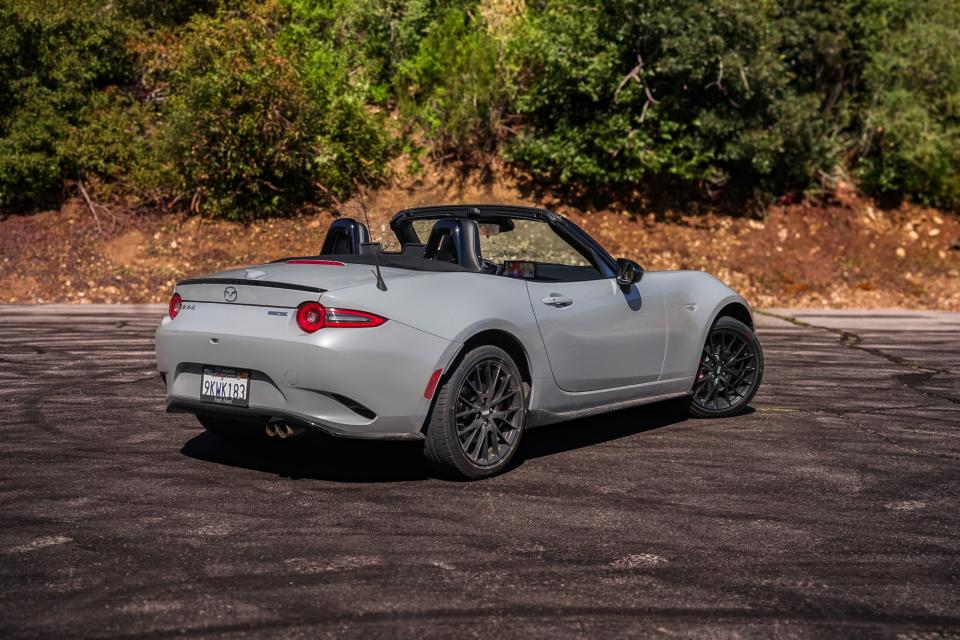
Why am I telling you this story? Because the ND Miata, with its almost unreal proportions, ultra-light curb weight, and a zippy little naturally aspirated 2.0-liter engine producing a not-that-whopping 181 horsepower and 151 lb-ft of torque is getting what will likely be its last updates before being sent off to a farm upstate in favor of a new, more eco-friendly hybrid replacement. It’s the end of an era for a car that’s universally loved and we should celebrate it.
What’s Changed?
The updates for the 2024 Miata aren’t numerous but they are notable. Chief among them are a new steering rack with revised electric power-assisted steering (EPAS) calibration and a new limited-slip differential out back. Neither of these fundamentally changes the character of the car, but each is additive to the Miata experience overall.
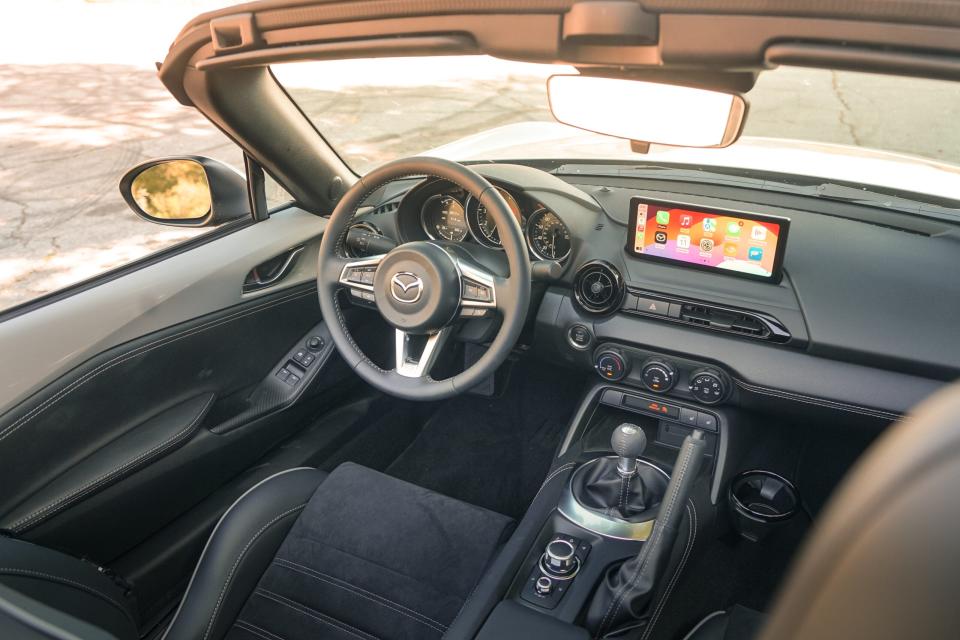
The change in the steering is the headline here because it’s the difference that people will experience the most. While the ND Miata never felt overly darty or nervous on the freeway, it did often require a lot of micro-corrections from the driver. It would get tiring after a while. Mazda has changed that by making the steering rack a bit slower just off-center. By this, I mean that it’s less sensitive and has become a much more relaxing experience during longer freeway slogs.
While there is likely some small penalty to be paid for this when it comes to overall accuracy or steering feel, it’s so minor as to be imperceptible by the vast majority of people. Plus, let’s face it, while the Miata’s steering is fine—good, even—it’s not like it’s chattering away at you, wriggling with information from the road surface like it’s an old Porsche 911. It’s just the price we pay for power steering and really, this latest change is for the good.



Next on the list of tweaks is a new limited-slip rear differential. Mazda calls it an asymmetric differential, and it’s cool because it uses a conical clutch with a cam mechanism that Mazda claims increases lockup under acceleration and reduces it on deceleration leading to more neutral handling and a more playful car. Does it work? You bet your ass it does. The Miata is still as friendly and willing to step its tail out whenever you push it, but if anything it’s even more controllable.
Another new feature that dovetails with the platform’s penchant for playing around is the addition of a track-focused stability control mode that Mazda calls DSC-Track Mode. This serves as a middle step between full-on and totally off and it allows a healthy amount of slipping and sliding without letting you get into trouble. It doesn’t intervene too aggressively either when it does decide to step in, so there’s no reason to defeat traction control fully on the road anymore. It’s activated by long-pressing the DSC button left of the steering wheel. Easy-peasy.


Less substantive changes to the MX-5 for 2024 include updated daytime running lights (DRLs), slightly more padding on interior surfaces like the center console, and a new paint color called Aero Gray that sees Mazda join the non-metallic primer crowd. It’s cool and suits the car. Back again is the aptly named Brembo/BBS/Recaro package that adds Brembo brakes, BBS wheels, and heated Recaro seats with speakers in the headrests. That’s a $4,800 option but a worthwhile one.
Mazda has historically been one of the more annoying brands when it comes to infotainment systems. Its staunch refusal to allow touchscreens for years felt almost spiteful, but with the refreshed Miata, it has relented somewhat with an updated version of Mazda Connect. The '24 MX-5 comes with wireless Apple CarPlay with plans to add wireless Android Auto in the near future. You’re able to use the touchscreen with CarPlay, but the catch is that you can only use it with CarPlay. Want to do anything in Mazda’s native system and you’re back to the control knob in the center console. The system is about 9,000% less hateful than before but still feels a little behind the times.



What Hasn't Changed?
Something that definitely hasn’t changed for 2024 is the Miata’s excellent ride quality. Seriously, this little hardcore, minimalist roadster has a more compliant and comfortable suspension than some luxury cars costing twice as much. Part of this comes down to the fact that because the Miata is so lightweight, Mazda can use lighter-weight springs and softer dampers to control the body. Another part of it is that Mazda has never seemed overly concerned about eliminating body roll, instead using it as a way to make what is actually kind of a slow car feel much faster and more dramatic.
The Brembo brakes are similarly excellent. They feel unflappable no matter how many times I dive into a corner, heel-toe downshifting to stay in the powerband. Again, because the brakes only have to slow down 2,300 pounds of car, they’re not actually working that hard. Because they’re not working that hard, they don’t generate that much heat, and less heat means more consistent performance.
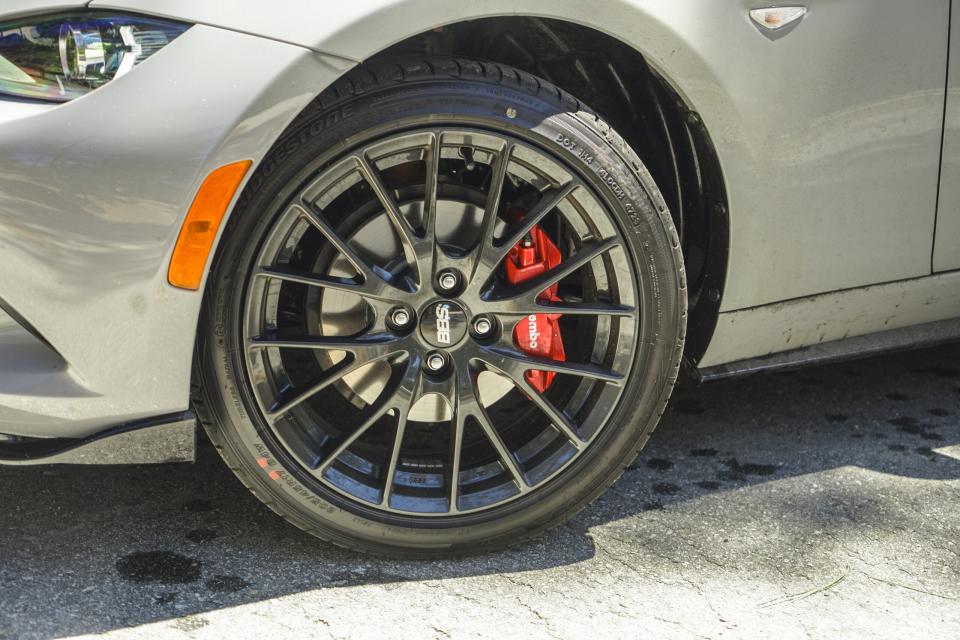
Lastly, the Miata’s gearbox—and oh, what a gearbox—is unchanged. I love a vehicle with a manual transmission, but I don’t believe that any vehicle is better just by virtue of having one. If you’re not going to do it well, then give me a ZF eight-speed and call it a day. [Ed. note: Amen. -CT] Friends, the Miata’s six-speed manual remains one of the best-shifting 'boxes of all time. It’s hyper-direct and slick. It’s one of the best-feeling gearboxes you can buy short of something like a 718 Porsche. The clutch is also nice, light, and almost stupidly easy to modulate. Automatic hill-hold is an awesome feature, too, though the option of auto rev-matching would be nice.
Things Change, Things Stay The Same
On that awful day all those years ago, sure, I couldn’t get my six-foot-four frame into the Miata with the top up and I, being of the “white as Wonder Bread” extraction was sunburned within an inch of the burn ward. And this being the pre-update version, it was slow-w-w-w, but squeezing myself into that little car and driving it within an inch of its life got me through that week. Then, I got through the next one and the one after that, and before too long, I got my first shot at being a real automotive journalist.
As you’ve been reading this, you have probably noticed me using a lot of words like friendly, playful, and easy. These are words that have always been used to describe Mazda’s Miata and it’s that approachability that’s made it so beloved among drivers. Even people who have the opportunity to drive some of the fastest cars in the world regularly (e.g. race car drivers and, yes, fellow auto journalists) often own and love Miatas.
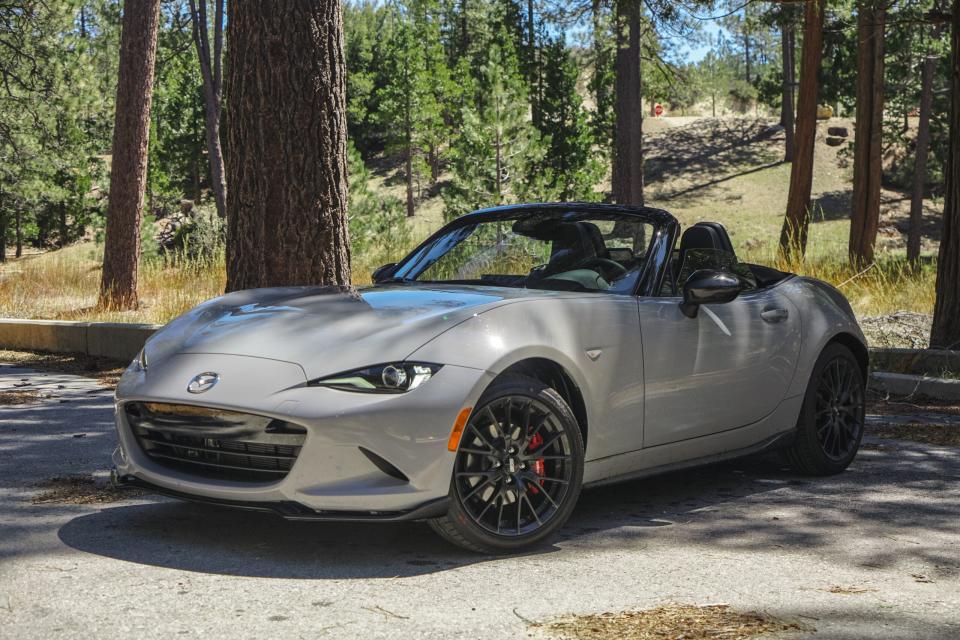
Will that change as the car inevitably is forced to gain size, weight, and complexity? I believe wholeheartedly that it won’t. When it goes hybrid, the next generation of Miata probably isn’t going to weigh 2,300 pounds or have a footprint only slightly larger than most golf carts. But while those things are important to Miata buyers now, I genuinely don’t think the core driving experience will deviate all that much.
There is an overwhelming passion for cars among Mazda designers and engineers and it’s this that separates Mazda from so many other manufacturers. It’s a company made of driving enthusiasts and weekend racers and you can feel that in everything that the company builds, but it’s most clearly felt in the Miata. Hell, that passion is why Mazdas are almost always the most fun-handling cars in their class, even if they’re rarely the most powerful, sophisticated, or popular among buyers.
Now, this may be a somewhat controversial opinion, but I believe that the fourth-generation Miata—this updated and refined 2024 Mazda MX-5 being the pinnacle—will go down as the best Miata ever made. No, it’s not as historically significant as the first generation with its adorable pop-up headlights and reliability that effectively killed the British roadster hegemony. But as a car that most typifies that connectedness between car and driver and overall competency on road or track—or just as a car that exudes enough joy to get you through a tough week—no other Miata comes close.
2024 Mazda MX-5 Specs | |
|---|---|
